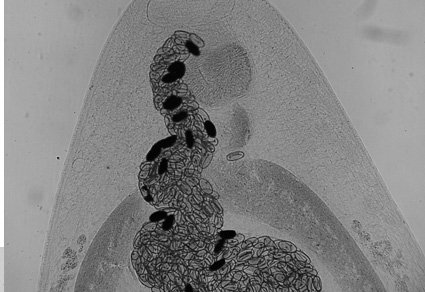Abstract
Seventeen specimens of the spotted rail, Pardirallus maculatus (Boddaert) (Gruiformes: Rallidae), from the southern Brazil were examined for helminths. Three birds were positive for specimens of Cyclocoelidae (Digenea), which were found in both nasal and abdominal cavities. Helminths were described as Nasuscoelum pampensis n. gen., n. sp. The new genus has an intertesticular ovary forming a triangle with the testis, characterizing the Cyclocoelinae. Nasuscoelum pampensis n. gen., n. sp. is similar to Cyclocoelum mutabile (Zeder, 1800), however it differs from the latter by the presence of vitelline follicles confluence in the posterior region. A revised key to the Cyclocoelinae was proposed to include the new genus.
References
- Bencke, G.A., Chomenko, L., Becker, A.N., Heidrich, Á.L., Trentin, A.M., Sant’Anna, D.M.,Suertegaray, D.M.A., Souza, F.A.L. & Verdum, R. (2016) Nosso Pampa desconhecido. Fundação Zoobotânica do Rio Grande do Sul Porto Alegre, Porto Alegre, 212 pp.
- Boldrini, L.L., Ferreira, P.M. de A., Andrade, B.O., Schneider, A.A., Setubai, R.B., Trevisan, R. & Freitas, E.M. de (2010) Bioma Pampa: diversidade florística e fisionômica. Editora Pallotti, Porto Alegre, 64 pp.
- Bush, A.O., Lafferty, K.D., Lotz J.M. & Shostak, A.W. (1997) Parasitology meets ecology on its own terms: Margolis et al. revisited. Journal of Parasitology, 83 (4), 575–583. https://doi.org/10.2307/328422
- De La, Peña, M.R. (2002) Observaciones de campo en la alimentación de las aves. Revista FAVE, 1 (2), 99–107. https://doi.org/10.14409/favecv.v1i2.1377
- De La Peña, M.R. & Rumboll, M. (1998) Birds of Southern South América and Antarctica. Collins, London, 304 pp.
- Dronen, N.O. (2007) Revision of the family Cyclocoelidae Stossich, 1902 with the proposal of two new subfamilies and the description of a new species of Morishitium Witenberg, 1928 from the common snipe, Gallinago gallinago, from Texas, U.S.A. Zootaxa, 1563 (1), 55–68. https://doi.org/10.11646/zootaxa.1563.1.5
- Dronen, N.O. & Blend, C.K. (2015) Updated keys to the genera in the subfamilies of Cyclocoelidae Stossich, 1902, including a reconsideration of species assignments, species keys and the proposal of a new genus in Szidatitreminae Dronen, 2007. Zootaxa, 4053 (1), 1–100. https://doi.org/10.11646/zootaxa.4053.1.1
- Dronen, N.O., Al-Kassar, N.R., li, A.H., Abdulhameed, M.F., Abdullah, B.H. & Al-Mayah, S.H. (2017) Intraspecific variation in adult Uvitellina iraquensis Dronen, Ali & Al-Amura, 2013 (Cyclocoelidae: Haematotrephinae) from two collection sites of white-tailed lapwing, Vanellus leucurus (Lichtenstein) (Charadriiformes: Charadriidae), in Iraq. Zootaxa, 4242 (1), 1–33. https://doi.org/10.11646/zootaxa.4242.1.1.
- Dronen, N.O. & Tkach, V.V. (2014) Key to the species of Morishitium Witenberg, 1928 (Cyclocoelidae), with the description of a new species from the red-billed blue magpie, Urocissa erythrorhyncha (Boddaert) (Corvidae) from Guizhou Province, People’s Republic of China. Zootaxa, 3835 (2), 273–282. https://doi.org/10.11646/zootaxa.3835.2.7
- Esteves, F. de A. (1998) Fundamentos de limnologia. 2nd Edition. Interciência, Rio de Janeiro, 602 pp.
- Fernandes, B.M.M. (1976) Sobre as espécies Brasileiras da Família Cyclocoelidae Kossack 1911 (Trematoda, Cyclocoelidae). Memórias do Instituto Oswaldo Cruz, 74 (3–4), 289–294. https://doi.org/10.1590/S0074-02761976000300008
- Fernandes, B.M.M, Justo, M.C.N., Cárdenas, M.Q. & Cohen, S.C. (2015) South American trematodes parasites of birds and mammals. Instituto Oswaldo Cruz, FIOCRUZ, 516 pp.
- García-R, J.C, Gibb, G.C. & Trewick, S.A. (2014) Deep global evolutionary radiation in birds: diversifcation and trait evolution in the cosmopolitan bird family Rallidae. Molecular Phylogenetics and Evolution, 81 (1), 96–108. https://doi.org/10.1016/j.ympev.2014.09.008
- Gómez, A. & Nichols, E. (2013) Neglected wild life: Parasitic biodiversity as a conservation target. International Journal for Parasitology: Parasites and Wildlife, 2, 222–227. https://doi.org/10.1016/j.ijppaw.2013.07.002
- Gomez-Puerta, L.A., Salas, M.Y., Lopez-Urbina, M.T. & Gonzalez, A.E. (2018) Morphological and molecular diagnosis of Cyclocoelum mutabile (Trematoda: Cyclocoelidae) in Peru. Revista Peruana de Biologia, 25 (3), 315–320. https://doi.org/10.15381/rpb.v25i3.15214
- IBGE (2004) Ministério do meio ambiente: Bioma Pampa. Available from: https://antigo.mma.gov.br/biomas/pampa.html (accessed 26 January 2022)
- Kanev, I., Radev, V. & Fried, B. (2002) Family Cyclocoelidae Stossich, 1902. In: Gibson, D.I., Jones, A. & Bray, R.A. (Eds.), Keys to the Trematoda. Vol. 1. CABI Publishing, Wallingford, pp. 131–145.
- Kenneth, C.P., Kibbe, D.P. & Roth, E.L. (1978) First records of the Spotted Rail (Pardirallus maculatus) for the United States, Chile, Bolivia and western Mexico. American Birds, 32 (3), 1–5. [https://sora.unm.edu/sites/default/files/journals/nab/v032n03/p00295-p00299.pdf]
- Lafferty, K.D. (2012) Biodiversity loss decreases parasite diversity: theory and patterns. Philosophical Transactions of the Royal Society B, 367 (1604), 2814–2827. https://doi.org/10.1098/rstb.2012.0110
- Lafferty, K.D. (2008) Ecosystem consequences of fish parasites. Journal of Fish Biology. 73(9), 2083–2093. https://doi.org/10.1111/j.1095-8649.2008.02059.x
- Lunaschi, L.I., Cremonte, F. & Drago, F.B. (2007) Checklist of digenean parasites of birds from Argentina. Zootaxa, 1403 (1), 1–36. https://doi.org/10.11646/zootaxa.1403.1.1
- Navas, J.R. (1991) Gruiformes. Fauna de agua dulce de la República Argentina. 43 (2). FECIC, Buenos Aires, Argentina, 80 pp.
- Poulin, R. (1995) “Adaptive” changes in the behavior of parasitized animals: a critical review. International Journal for Parasitology, 25 (12), 1371–1383. https://doi.org/10.1016/0020-7519(95)00100-x
- Sitko, J., Bizos, J. & Heneberg, P. (2016) Central European parasitic flatworms of the Cyclocoelidae Stossich, 1902 (Trematoda: Plagiorchiida): molecular and comparative morphological analysis suggests the reclassification of Cyclocoelum obscurum (Leidy, 1887) into the Harrahium Witenberg, 1926. Parasitology, 144 (4), 368–383. https://doi.org/10.1017/S0031182016001955
- Strona, G. (2015) Past, present and future of host-parasite co-extinctions. International Journal for Parasitology: Parasites and Wildlife, 4 (3), 431–441. https://doi.org/10.1016/j.ijppaw.2015.08.007
- Verones, F., Saner, D., Pfister, S., Baisero, D., Rondinini, C. & Hellweg, S. (2013) Effects of consumptive water use on biodiversity in wetlands of international importance. Environmental science & technology, 47 (21), 12248–12257. https://doi.org/10.1021/es403635j
- Wood, C.L., Byers, J.E., Cottingham, K.L., Altman, I., Donahue, M.J. & Blakeslee, A.M.H. (2007) Parasites alter community structure. Proceedings of the National Academy of Sciences of the United States of America, 104 (22), 9335–9339. https://doi.org/10.1073/pnas.0700062104
- Zeder, J.G.H. (1800) Erster Nachtrag zur Naturgeschichte der Eingeweidewümer mit zufässen und Anmerkungen. Herausgegeben von Johann Georg Heinrich Zeder. Siegfried Liver-genuinly Crusius, Leipzig, 320 pp.


